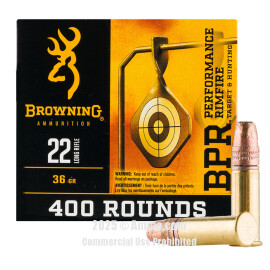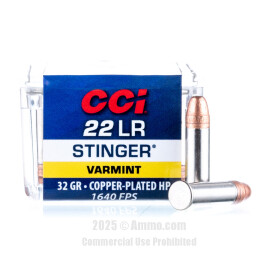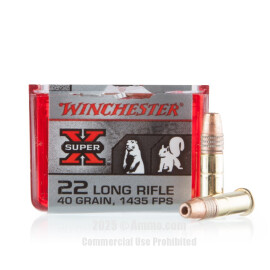Top 5 Best .22 LR for Self-Defense: The Itty Bitty Defender
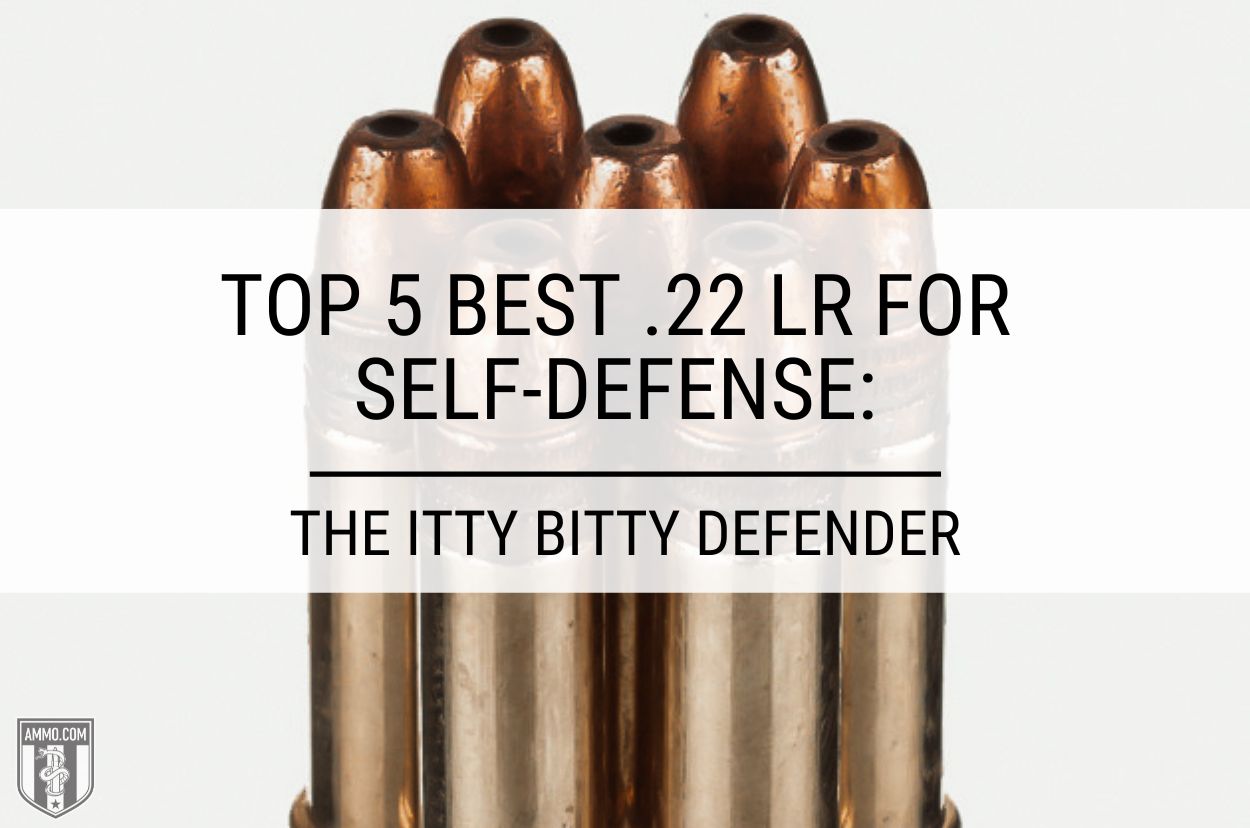
Let's get this out of the way, right away:
The 22 LR is NOT the best choice for self-defense.
There. We said it.
No one will deny that the 22 Long Rifle cartridge is a great training tool for newer shooters. It's low recoil, low report, and low cost all make it that way. It's stellar for plinking and pest control, too.
But the 22 LR isn't all-talented. Larger cartridges like the 9mm, 38 Special, and 45 ACP are all better for self-defense.
The 22 LR doesn't inflict a very deep or wide wound channel. Its wounding characteristics are confirmed "not good" by FBI ballistic gelatin tests. The 22 LR's bullet is light relative to its muzzle velocity, which translates to low striking energy and poor penetration. The 22 LR bullet is also relatively narrow (.22"), and therefore inflicts a thin wound channel relative to rounds like 9mm Luger (.355") and 10mm Auto (.400").
Despite these (serious) shortcomings, the 22 LR offers two great advantages: its small size, and its low recoil. You can carry an extremely small 22 LR pistol. You can also fire it with very little muzzle flip (the force which throws your aim off target with each shot).
That latter advantage is a big plus for shooters with smaller frames. It gives them the option of carrying a Ruger LCR or Taurus TX22, and keeping its muzzle trained precisely where it should be during a life-or-death altercation. And at the end of the day, if you can place 22 LR bullets precisely where you mean to, then you can effectively neutralize most conventional threats.
If you've determined to defend yourself with a 22 LR pistol or rifle, then you had better pick the correct ammunition. Bad ammo has a higher chance of not firing, missing, or inadequately wounding the threat. Good ammo will maximize your chance of survival – something you are advised to always maximize (unless you're defending your kids, under which circumstance your own odds of survival take a distant backseat).
Here are our top 5 picks of the best 22 LR self-defense loads on the market today (plus a few honorable mentions)!
If you want to place an order now, grab a few boxes of Browning Performance Rimfire 36 grain CPHP. If you want to explore the best .22 LR rimfire ammunition for self-defense, keep reading.
If you’re new to buying .22LR ammo, check out our Buyer’s Guide HERE to learn more. Otherwise, keep scrolling for the top 5 best 22LR ammo you can buy to defend your life.
The Best .22 LR for Self-Defense
- Browning Performance Rimfire 36 Grain CPHP
- CCI Stinger 32 Grain CPHP
- Winchester Super-X 40 Grain CPHP
- Aguila 38 Grain CPHP
- Federal Punch Defense 29 Grain Nickel Plated Flat Nose
Best 22 LR for Self-Defense - Overall
Browning Performance Rimfire 36 Grain CPHP
Specs
- Case: Brass
- Bullet Type: Copper-Plated Hollow Point (CPHP)
- Bullet Weight: 36 grains
- Muzzle Velocity: 1,280 fps
- Muzzle Energy: 131 ft-lbs
Pros
- Affordable
- Easy to find
- Clean-shooting and expanding bullet
Cons
- Questionable reliability is some handguns
Why We Chose It
As far as rimfire cartridges go, you aren’t going to find many that are versatile enough for plinking, varmint hunting, and self-defense. To choose the best .22 LR ammo for self-defense, we had to consider reliability, price, performance, and availability. For us, that’s Browning Performance Rimfire 36 grain CPHP.
This round's copper-plated lead projectile is versatile enough to stop threats and rabbits. Be sure that its copper plating doesn't actually strengthen the bullet. It's there for better cosmetics, and to reduce lead fouling of the barrel. The CPHP's hollow point nose cavity is fully functional, however, and will expand to inflict a wound channel that is wider than .22".
This round's 36 grain bullet and 1,280 fps muzzle velocity (as recorded with a rifle-length barrel) give it decent striking energy, which is critical to determining a round's overall "stopping power."
Make sure to test this ammo in your preferred pistol before relying on it. I had some reliability issues with Browning ammo in my Walther P22. If you discover that your handgun likes this ammo, then you won't be disappointed by its performance.
Honorable Mention
Winchester Silvertip 37 Grain Segmented Hollow Point - Another hard-hitting 22 LR cartridge, with a projectile that is designed to fracture apart into smaller pieces after impact. Inflicts multiple shallower wound channels.
CCI Stinger 32 Grain CPHP
Specs
- Case: Nickel-Plated Brass
- Bullet Type: Copper-Plated Hollow Point (CPHP)
- Bullet Weight: 32 grains
- Muzzle Velocity: 1,640 fps
- Muzzle Energy: 191 ft-lbs
Pros
- Reliable
- Hollow point provides some expansion
- High availability
Cons
- Lower velocity in typical CCW handguns
Why We Chose It
If you want incredibly reliable 22 LR ammo that goes bang every time you squeeze the trigger, then make sure to grab some CCI Stinger.
CCI Stinger is loaded with smooth-feeding nickel-plated brass cases. This is beneficial for self-defense ammunition. By preventing a poorly timed jam, nickel plating could spell the difference between life and death.
CCI Stinger also has one of the highest muzzle velocities available for rimfire ammo, beating out CCI Mini-Mag and CCI Velocitor by a wide margin. Granted, that's the product of its unusually light bullet and nothing else, but 1,640 fps is fast. That's half the muzzle velocity of the 223 Rem!
Similar to the Browning ammo described earlier, a CCI Stinger round fires a copper-plated hollow point which commences terminal expansion immediately after impact. Expansion maximizes trauma to soft tissues surrounding the wound channel (although it may also cause the bullet to become lodged in soft tissue prior to reaching a vital organ).
One thing to keep in mind is that most (though not all) manufacturers report their muzzle velocities from test barrels longer than 16". In other words, you are certain to witness a significantly lower muzzle velocity out of any of the pistols you might choose for defense.
Short-barrel 22 LR pistols like the Ruger LCP will generally have a lower muzzle velocity than what's listed on the box. This isn't to say the rounds are ineffective, but it's something you should be aware of before choosing to carry a 22 LR handgun for self-defense.
CCI Stinger is fairly affordable, and easy to buy in bulk (and therefore stockpile). Take a few boxes to the range and ensure your 22 LR pistol (or rifle) likes it then keep the rest at home for a worst-case scenario. (Remember! If the whole world goes sideways, then you won't just want to defend yourself. You will also want to shoot any animal that can fit into a stew pot.)
Winchester Super-X 40 Grain CPHP
Specs
- Case: Brass
- Bullet Type: Copper-Plated Hollow Point (CPHP)
- Bullet Weight 40 grains
- Muzzle Velocity: 1,435 fps
- Muzzle Energy: 108 ft-lbs
Pros
- High velocity for a heavier bullet
- Very affordable
- High availability
Cons
- Imperfect reliability
Why We Chose It
Winchester Super-X 40 Grain CPHP is another excellent option for self-defense for those who want or need to use a .22 LR.
This high-velocity cartridge has a copper-plated hollow point. Recall that the bullet's plating doesn't actually improve its terminal ballistics. What really makes the CPHP effective is its capacity for terminal expansion, which inflicts a wider and altogether more harmful wound channel.
As with all ammo, some shooters experience feeding and accuracy issues with Winchester Super-X. Fortunately, it’s a pretty low-cost round, so getting to the range to test it (as you should with any self-defense rounds) isn’t going to break the bank.
Honorable Mention
Federal Champion 40 Grain LRN - Ultra reliable by one of the greatest manufacturers, and fairly hard hitting to boot. The LRN's inability to undergo terminal expansion can improve its odds of accessing a vital organ – with correct shot placement, that is.
Aguila 38 Grain CPHP
Specs
- Case: Brass
- Bullet Type: Copper-Plated Hollow Point (CPHP)
- Bullet Weight: 38 grains
- Muzzle Velocity: 1,280 fps
- Muzzle Energy: 138 ft-lbs
Pros
- Very accurate
- High reliability for its price point
- Lowest cost/round on our list
Cons
- None, beyond the rimfire primer's characteristically lower reliability
Why We Chose It
Aguila 38 grain CPHP ammo is typically the lowest-priced option on this list. It isn’t lacking in quality, though. Aguila is well known for producing dependable rounds that feed well (in most cases) and exhibit excellent accuracy.
This cartridge has a lower muzzle velocity than our other 22 LR recommendations for self-defense, but it also has excellent penetration characteristics, and isn’t likely to expand too quickly. Like our other recommendations so far, Aguila ammo is loaded with clean-shooting CPHP projectiles.
Honorable Mention
Fiocchi 38 Grain CPHP - Very similar alternative to Aguila's analogous load. An excellent round that can be used for self-defense as well as small game hunting and varmint control.
Federal Punch Defense 29 Grain Nickel Plated Flat Nose
Specs
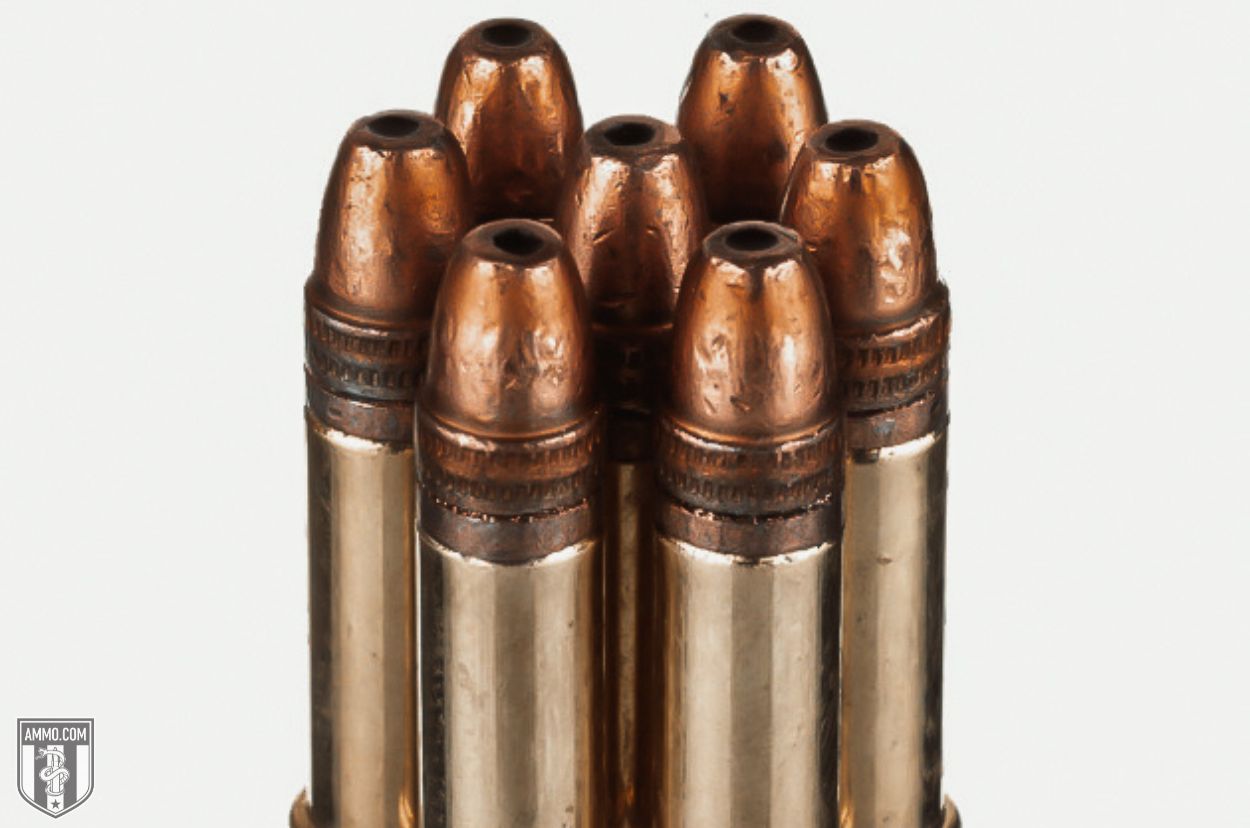
- Case: Nickel-plated brass
- Bullet Type: Nickel Plated Flat Nose (FN)
- Bullet Weight: 29 grains
- Muzzle Velocity: 1080 fps
- Muzzle Energy: 75 ft-lbs
Pros
- Specially designed for self-defense
- High-quality
Cons
- Not widely available
Why We Chose It
The 22 LR has plenty of drawbacks when it comes to self-defense. The smaller projectiles with lower muzzle velocities often achieve too little penetration to stop a threat immediately. Federal’s engineers recognized this drawback and designed this cartridge to overcome it.
This round's bullet is specifically designed NOT to expand. The nickel-plated FN projectile invests all of its energy into penetrating as deeply as possible. By forgoing expansion altogether, the bullet maximizes its odds of striking a vital organ
This round's bullet is abnormally light. That's why even a 2" barrel can deliver a muzzle velocity of 1,070 fps. (Out of a 24" barrel, muzzle velocity increases to 1,650 fps.) Its roaring fast muzzle velocity gives the nickel-plated FN more of the momentum requisite for – you guessed it – deep penetration.
This ammo's premium primers, consistent propellant charges, and low-friction (and corrosion-resistant) nickel-plated brass cases all contribute toward its outstanding reliability. Federal manufactures A LOT of ammo for law enforcement agencies, and knows how to engineer field-ready reliability.
Parting Shots
While we wouldn’t run out and buy a .22 over a Glock or a Ruger 9mm (or another semi-auto firearm that packs more punch), we would rather have a .22 than a pointy stick or baseball bat.
While many tout the .22 LRs' ineffectiveness in personal defense, it also has its benefits (especially if you’re using the best self-defense ammo available). For example, it’s an excellent caliber shooters who are extremely recoil sensitive or have weak hands.
So, if you plan to keep a few boxes of .22 LR ammo around in case the worst should happen, order one of the options above. If you want to pick up a few other boxes for plinking or target shooting, head over to our .22 LR ammo page for more cartridges.
If you’re interested in learning more, check out our Buyer’s Guide below, or visit our page where we test .22 LR ammo to help you find the best .22 LR ammo.
Buyer’s Guide: What to Look for in .22 LR Ammo
Welcome to our .22 LR buyer's guide! We’ll take a look at the various ins and outs of finding the right ammo for the task at hand.
Even the U.S. military still uses the .22 LR for training and marksmanship practice. Most of your .22 LR pistols and rifles are a lot of fun to shoot, and they’re great for learning basic marksmanship.
.22 LR Bullet Types Explained
Many of our ammo reviews cover various types of ammo (FMJs, JHPs, polymer tips, etc.). But in the case of the .22 LR, there are only so many options for effective bullet types in personal defense scenarios.
Let’s take a brief moment to break those down.
HP (Hollow Point)
One of the more common self-defense bullet types is the hollow point. There are many variations of hollow point bullets, from jacketed hollow points to copper-plated hollow points and more.
Hollow points are typically excellent for personal protection in close range engagements.
However, the .22 LR doesn’t usually doesn't have enough power for a hollow point bullet to expand very much, if at all. Hollow point 22 LR ammo .22 LR ammo is best suited for varmint hunting.
LHP (Lead Hollow Point)
The LHP is the more basic type of hollow point that can be loaded in a 22 LR cartridge. It lacks copper plating, but that doesn't impair its ability to deliver terminal expansion. The LHPs nose has a concave shape and offers better terminal ballistics on small game like squirrels and rabbits.
LRN (Lead Round Nose)
Another common .22 LR bullet is the lead round nose. These bullets are designed to maximize penetration. Unlike hollow points, they don’t expand or fragment well.
LRN bullets are the simplest, and typically loaded in the least expensive .22 LR ammo (with the exception of some match grade rounds, such as those made by Eley). They are easy to manufacture since they don't require specialized plating procedures.
CPRN (Copper-Plated Round Nose)
The copper-plated round nose is becoming the gold standard in the rimfire industry, and is extremely popular in 22 LR ammunition. It is similar to an LRN bullet, but is electroplated with a thin layer of copper. It shoots cleaner than its unplated brother, which isn't to say you can expect to see zero lead fouling while you're firing CPRN ammo.
CPHP (Copper-Plated Hollow Point)
The copper-plated hollow point's name includes its two defining features: copper plating, which slows the rate of lead fouling in the barrel, and hollow point, which delivers positive expansion that kills small game quicker and more surely. It's an ideal varmint hunting bullet, but not so dearly priced that you'd balk at using it for target practice.
.22 LR vs. .22 Magnum
While shopping for 22 LR ammo, you may come across .22 Mag (aka 22 WMR). They are extremely different cartridges. You may not fire 22 LR ammo in a 22 Mag firearm, and vice versa. Any attempt to do so would be pointless, and possibly dangerous.
The 22 Mag is a more powerful cartridge, with a longer case to store a larger payload of propellant. Its trajectory is flatter. Its striking energy is higher. Its effective range is longer. Its potential to neutralize a threat in one shot is higher.
If you want a .22 cal pistol for concealed carry, the .22 Mag is the better choice (albeit still not as good as 9mm).
Rimfire vs. Centerfire
What's the difference between a rimfire and a centerfire cartridge? It's simple. A centerfire round's primer is located in the center of its base. Conversely, a rimfire round's primer is contained within the rim circling its base. This is why a 22 LR firearm's firing pin strikes the rim of the cartridge – not its center.
The rimfire design is only possible with weaker cartridges (as more powerful ones require brass cases that are too thick for a firing pin to dent). The rimfire design also makes handloading impossible (or, to be more accurate, extremely inconvenient), and is inherently less reliable to boot. On the plus side, rimfire ammo is cheaper to manufacture – just one reason why 22 LR has a low cost per round (admittedly, this is also because it is very small).
To read more about the difference between rimfire vs. centerfire, check out this article: Rimfire vs. Centerfire Ammunition.
The History of the .22 LR
The birth of the modern day .22 LR began in 1857, when Smith & Wesson designed the Model 1 single-action pistol. At the time, the .22 rimfire cartridge’s case was .421" long (which now belongs to the .22 Short).
The .22 cartridge got a little longer and more powerful in 1871. With a longer .613" case, it was brilliantly named the .22 Long (ammo manufacturers weren’t as creative as Hornady or Remington when it came to naming their creations back then).
Finally, we got the .22 LR (Long Rifle) in 1887. It still had the .613" case. It also had a heavier projectile. In the early 1930s, Remington designed the high-velocity .22 LR, increasing the round's muzzle velocity and giving its bullet a few more foot-pounds of muzzle energy as a result.
To this day, we still use the .22 LR (mostly in carbines like the Ruger 10/22, semi-auto pistols like the Walther P22, and revolvers like the Ruger LCR). The .22 LR packs more of a punch than its predecessor, but is still an affordable round perfect for small game hunting and target shooting.
Back to the Best .22 LR for Self-Defense
Now that you have a clearer understanding of .22 Long Rifle ammo, you can click HERE to return to our list and place an order (or two).
Cartridge Recommendations
- Best Caliber for Deer Hunting
- Best Big Game Caliber
- The 10 Best Coyote Cartridges
- Best Cartridge for Elk Hunting
- Best Cartridge for Self-Defense
- Best Cartridge for Concealed Carry
- Best Handgun Cartridge
- Best Moose Cartridges
- Best 40 S&W Ammo For Self Defense & Target Practice
- Best 223 Ammo
- Best .44 Magnum Ammo
- Best 270 Ammo for Hunting
- Best 17 HMR Ammo for Varmint Hunting and Plinking
- Best 22 Rimfire Ammo
- 4 Best AK-47 Ammo Picks [7.62x39]
- Best 38 Special Ammo for Self Defense
- Best Handgun Ammo for Self-Defense in Common Calibers
- Best 308 Ammo For Hunting & Target Shooting
- Best 300 Win Mag Ammo
- Best 243 Ammo for Target Shooting
- 10 Best 6.5 mm Cartridges For Long-Range Shooting and Hunting
- Best 45 ACP Hollow Points for Self-Defense
- Best 12 Gauge Ammo for Home Defense
- Best 32 ACP Ammo for Your Pocket Pistol or Backup Gun
- Top 13 Best AR Calibers That Aren’t 5.56 NATO
- Best Ammo for Smith and Wesson M&P 9mm Shield
- Best 7.62x39 Ammo for Self Defense
- Best 20 Gauge Ammo for Home Defense, Whitetail, and Upland Game
- Best Ammo for 1911 45 ACP
- Best 12 Gauge Ammo for Deer Hunting
- Best .40 S&W Ammo for Self Defense
- Best 7.62x39 Hunting Ammo
- Best 5.56 Ammo for Home Defense
- Best 380 Self-Defense Ammo
- Best 45 ACP Ammo for Every Situation
- Best Ammo for Glock 43x
- Top 5 Best 22 WMR Ammo on the Market
- Best Ammo for Glock 19
- Best Sniper Ammo
- Best 38 Special Ammo For Target Practice Precision Shooting
- Top 5 Best 45 ACP Ammo for Target Practice
- Best 6.5 Creedmoor Hunting Ammo
- Top 10 Best Sniper Rifle Cartridges
- Best 6.5 Grendel Ammo
- Best 5.45x39 Ammo for Your Gun
- Best 10mm Ammo for Bear Defense
- Best 350 Legend Ammo
- Top 5 Best 30-06 Ammo for Deer Hunting
- Best 30-06 Ammo for Accuracy
- Best 300 Win Mag Ammo for Deer
- Best M193 Ammo for Stockpiling
- Best 300 Blackout Ammo for a 7.5" Barrel
- Best Shotgun Shells for Target Practice
- Best 45 ACP for Bear Defense
- Best 223 for Deer Hunting
- Best Exotic 9mm Ammo
- Best Duck Hunting Shells
- Best .357 SIG Defensive Ammo
- Best Beretta APX 9mm Ammo
- Best 22 Pistol Ammo
- Best 9mm Ammo
- Best 308 Ammo for Deer Hunting
- Best Ammo for the Taurus GX4
- Best Ammo For Taurus PT111 G2
- Best Shells For Trap Shooting
- Best 38 Special Ammo for Snubbies
- Best 410 Ammo For A Taurus Judge
- Best Ammo for Ruger Security 9
- Best Ammo for Taurus G3c
- Best 7mm Rem Mag Ammo
- Best Lead-Free Hunting Ammunition
- Best 300 Blackout Ammo for Hog Hunting
- Best 9mm Home Defense Ammo
- Best 10mm Ammo for Every Shooting Situation
- Best .22 LR Ammo for Self-Defense
- Best Long-Range Hunting Bullets
- Best 357 Magnum Ammo For Every Shooting Situation
- Best 45 ACP Ammo For Self-Defense
- Best 6.5 Creedmoor Ammo For Accuracy
- Best 45-70 Ammo For Hunting & Target Shooting
- Best Turkey Loads
- Deadliest Shotgun Ammo For Home Defense
- Best 300 Win Mag Ammo For Elk Hunting
- Best 9mm Subsonic Ammo
- Best 7mm PRC Ammo
- Best 300 Blackout Subsonic Ammo
- Best 308 Subsonic Ammo for Hunting
